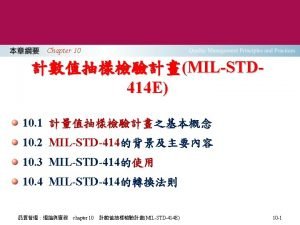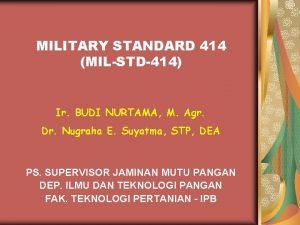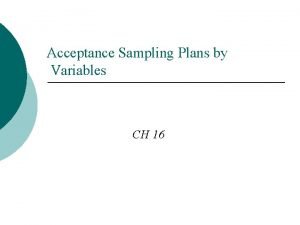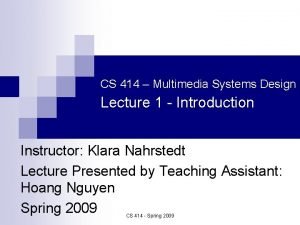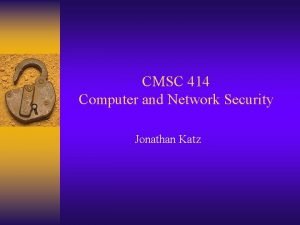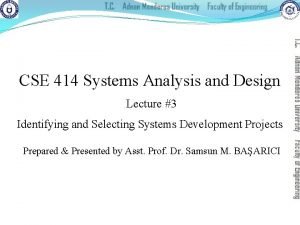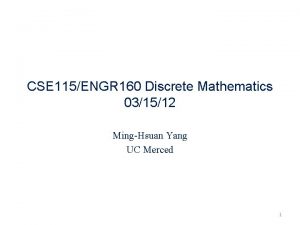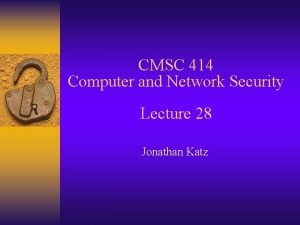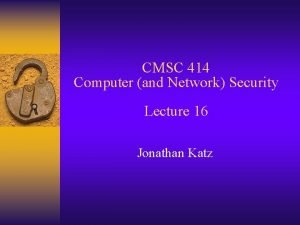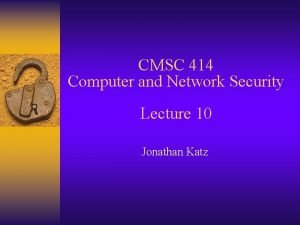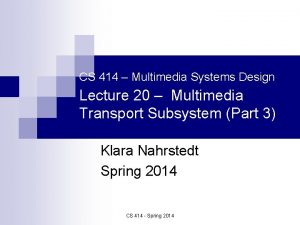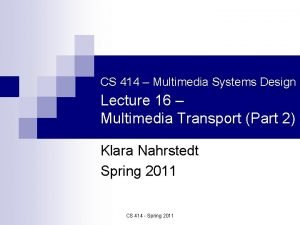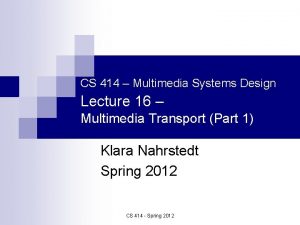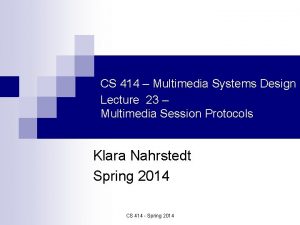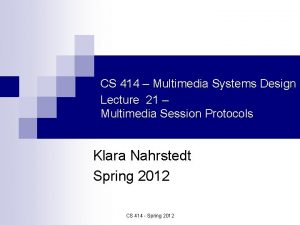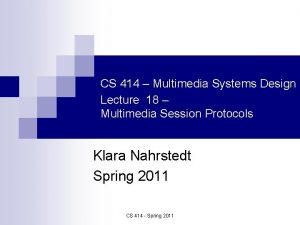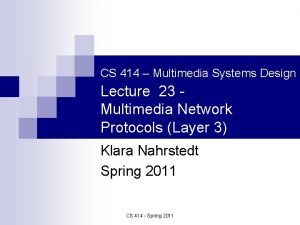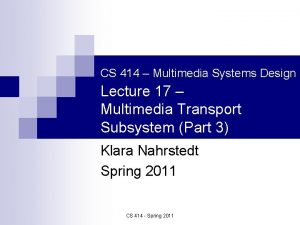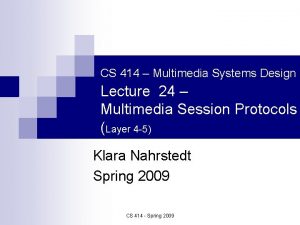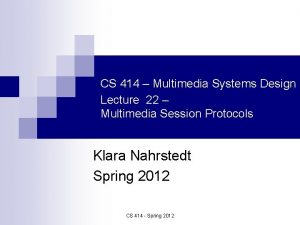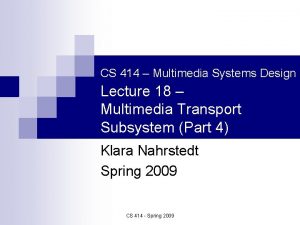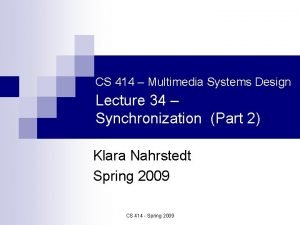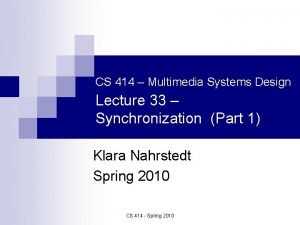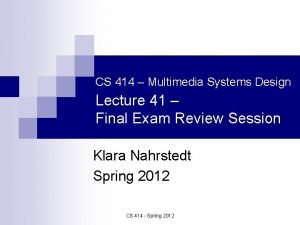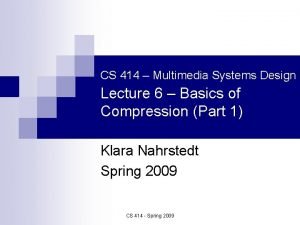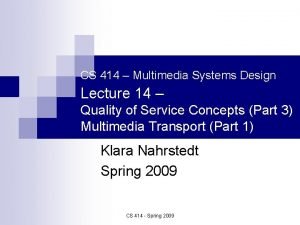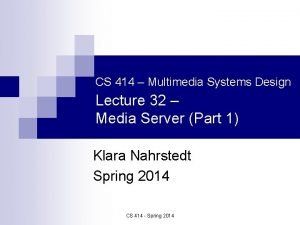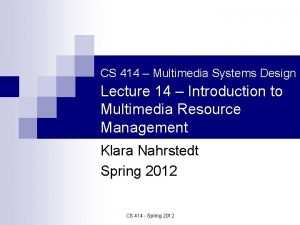CS 414 Multimedia Systems Design Lecture 19 Multimedia
























- Slides: 24

CS 414 – Multimedia Systems Design Lecture 19 – Multimedia Transport Subsystem (Part 2) + Midterm Review Klara Nahrstedt Spring 2014 CS 414 - Spring 2014

Midterm March 7 (Friday), 1 -1: 50 pm, 0216 SC n Closed Book, Closed Notes n You can bring calculator and 1 page cheat sheet n CS 414 - Spring 2014

Covered Material n n n Class Notes (Lectures 1 -15) MP 1 Book Chapters to read/study: ¨ Media Coding and Content processing book Chapter 2, n Chapter 3. 1 -3. 2, 3. 8, n Chapter 4. 1 -4. 2. 2. 1, n Chapter 4. 3 (as discussed in lecture) n Chapter 5, chapter 7. 1 -7. 5, 7. 7 n CS 414 - Spring 2014

Material n Audio Characteristics ¨ Samples, frequency, Nyquist theorem ¨ Perception, psychoacoustic effects, loudness, pitch, decibel, intensity ¨ Sampling rate, quantization n Audio Characteristics ¨ PCM, DPCM, signal-to-noise ratio CS 414 - Spring 2014

Material n Image Characteristics ¨ Sampling, quantization, pixels ¨ Image properties: color CS 414 - Spring 2014

Material n Video technology ¨ Color perception: hue, brightness, saturation, ¨ Visual representation: horizontal and vertical resolution, aspect ratio; depth perception, luminance, temporal resolution and motion ¨ Flicker effect ¨ Color coding: YUV, YIQ, RGB ¨ NTSC vs HDTV formats CS 414 - Spring 2014

Material n Basic Coding schemes ¨ Run-length coding ¨ Statistical coding Huffman coding n Arithmetic coding n n Hybrid codes ¨ JPEG: image preparation, DCT transformation, Quantization, entropy coding, JPEG-2000 characteristics CS 414 - Spring 2014

Material n Hybrid Coding ¨ Video MPEG: image preparation, I, P, B frames characteristics, quantization, display vs processing/transmission order of frames ¨ Audio MPEG: role of psychoacoustic effect, masking, steps of audio compression ¨ MPEG-4: differences to MPEG-2/MPEG-1 n Audio-visual objects, layering ¨ H. 261, 263, 264, 265 CS 414 - Spring 2014

Sample Problems Consider the following alphabet {C, S, 4, 1}, with probabilities: P(C) = 0. 3, P(S) = 0. 2, P(4)= 0. 25, P(1) = 0. 25. n Encode the word CS 414 using n ¨ Huffman coding and arithmetic coding ¨ Compare which encoding requires less bits CS 414 - Spring 2014

Sample Problems n Describe briefly each step in MPEG-1 audio encoding. Specify the functionality, which is performed in each step. You don’t have to provide equations, only a clear explanation of the functionality that is performed inside each step. CS 414 - Spring 2014

Sample Problems What is flicker effect and how to remove it? n Provide five differences between MPEG-4 video encoding standard and the previous MPEG video encoding standards n CS 414 - Spring 2014

Covered Aspects of Multimedia Image/Video Capture Audio/Video Perception/ Playback Audio/Video Presentation Playback Image/Video Information Representation Transmission Audio Capture Transmission Compression Processing Audio Information Representation Media Server Storage CS 414 - Spring 2014 A/V Playback

We have discussed so far Quality of Service n Multimedia Data Establishment Protocol n ¨ Negotiation and Translation of Qo. S CS 414 - Spring 2014

What we will talk about today n Multimedia Call Establishment Protocol ¨ Admission and Reservation Operations Bandwidth Admission n Processing Admission n n Data Streaming/Transmission Operations ¨ Traffic Shaping CS 414 - Spring 2014

Bandwidth Admission Test n Consider bi – reserved bandwidth for the ‘i’ connection ¨ Bmax – maximal bandwidth at the network interface ¨ n n Admission test (if all connections declare their bandwidth requirements bi at the same time): ¨ ∑ b ≤ Bmax (i=1, …n) i Example: n n n ¨ Bmax = 100 Mbps, Bandwidth requirement of connection 1 b 1 = 10 Mbps Bandwidth requirement of connection 2 b 2 = 20 Mbps Admission Control Condition: b 1 + b 2 < Bmax n n Step 1: if b 1 < Bmax then admit b 1, reserve b 1, adjust Bmax to Bavail = Bmax – b 1 Step 2: if b 2 < Bavail then admit b 2, reserve b 2, adjust Bavail to Bavail = Bavail – b 2 CS 414 - Spring 2014

Packet/Frame Scheduling Admission Systems have queues n We need packet/frame scheduling policies for admitting new streams n We need frame/packet schedulability tests n ¨ Note that in networking only NONPREEMPTIVE scheduling exists!!! CS 414 - Spring 2014

Packet/Frame Scheduling Admission Control ei – processing of a packet ‘i’ in network node Admission Test: ei ≤ deadline ∑ servei/ (1/r) ≤ 1 (i=1, …, n) serve – packet/frame service time at the processors – constant time due to hardware implementation q_in and q_out are queuing times N – number of packets in queue λ – service rate q = N/λ (Little Theorem) r – service rate of the switch 1/r – packet/frame period on CS 414 - Spring 2014 processor

Resource Reservation/Allocation n Bandwidth reservation ¨ Pessimistic reservation with maximal bandwidth allocation: Given (MN, RA, and MA) n if then CS 414 - Spring 2014

Pessimistic Resource Reservation (Example) n n Example: Consider sequence of MPEG video frames of size 80 KB, 60 KB, 20 KB, 60 KB, 20 KB (Group of Pictures I, P, B, B ), Pessimistic frame size calculation: ¨ n n MA = max(80, 60, 20, 20) = 80 KB Given video frame rate RA = 20 fps If Given MN = 10 KB (network packet size, e. g. , packet size for the transport layer like TCP/UDP), then need to consider bandwidth/ throughput reservation for ¨ BN = 10 KB x (8 network packets per application frame) x 20 application frames per second= 1600 KB/second = 12800 Kbps CS 414 - Spring 2014

Optimistic Resource Reservation/Allocation Optimistic reservation considers average bandwidth allocation n Given MA, RA, MN, where n n Then CS 414 - Spring 2014

Optimistic Resource Reservation (Example) n n Example: Consider sequence of MPEG video frames of size 80 KB, 60 KB, 20 KB, 60 KB, 20 KB (Group of Pictures I, P, B, B, ), Optimistic frame size calculation: ¨ n n MA = 280/7 = 40 KB Given video frame rate RA = 20 fps If Given MN = 10 KB (network packet size, e. g. , packet size for the transport layer like TCP/UDP), then need to consider bandwidth/ throughput reservation for ¨ BN = 10 KB x (4 network packets per application frame) x 20 application frames per second= 800 KB/second = 6400 Kbps CS 414 - Spring 2014

Sender-Oriented Reservation Protocol CS 414 - Spring 2014

Receiver-Oriented Reservation Protocol CS 414 - Spring 2014

Conclusion n Multimedia Call Establishment Protocol requires ¨ Qo. S Parameter negotiation (exchange) ¨ Qo. S Parameter translation ¨ Admission Control of resources needed to provide Qo. S requirements Bandwidth admission n Frame/Packet scheduling admission n ¨ Reservation of resources for admitted multimedia streams CS 414 - Spring 2014
 01:640:244 lecture notes - lecture 15: plat, idah, farad
01:640:244 lecture notes - lecture 15: plat, idah, farad Mil-std-414
Mil-std-414 Mil-std-414
Mil-std-414 Mil std 414
Mil std 414 414 climate change
414 climate change Cs 414
Cs 414 Cmsc 414
Cmsc 414 Cse 414
Cse 414 Gcd of 414 and 662
Gcd of 414 and 662 Cmsc 414
Cmsc 414 Cmsc 414
Cmsc 414 Cmsc 414
Cmsc 414 Advanced operating system notes
Advanced operating system notes Lecture sound systems
Lecture sound systems Lecture sound systems
Lecture sound systems Multimedia becomes interactive multimedia when
Multimedia becomes interactive multimedia when Examples of non linear multimedia
Examples of non linear multimedia Csc253
Csc253 Esa multimedia.esa.int./multimedia/virtual-tour-iss
Esa multimedia.esa.int./multimedia/virtual-tour-iss Anchorage length eurocode
Anchorage length eurocode Urban design lecture
Urban design lecture Elements of interior design ppt
Elements of interior design ppt Lecture hall acoustics
Lecture hall acoustics Game design lecture
Game design lecture Computer-aided drug design lecture notes
Computer-aided drug design lecture notes

